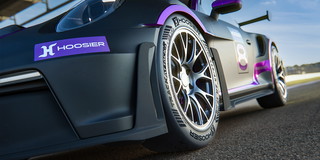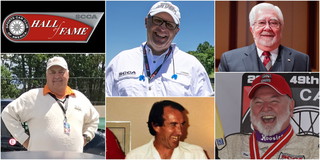
This article first appeared in the May, 2016 edition of SportsCar Magazine. SCCA members can read the current and past editions of SportCar digitally here after logging into their account; To become an SCCA member and get SportsCar mailed to your home address monthly in addition to the digital editions, click here.
Is your car not handling the corners like it should? We take the guess work and confusion out of your handling woes
Competition class rules often limit the suspension parts that may be used on a given car, and therefore the adjustability of that car. Despite that, all racecars must obey the basic laws of physics, so there is common ground where every racer can learn a little more about how a car’s suspension leads to spectacular grip or evil handling. But before we get into how things affect a car’s handling, let’s start with the basics.
Springs are simple devices, but choosing the springs can be difficult. The springs are there to isolate the bulk of the weight of your racecar from the bumps and motions of the road under the wheels. Springs help keep the entire mass of the vehicle from responding every time you drive over the curbs or bumps.
The main variables you can adjust with springs are the total height and the spring rate. Spring rate is expressed as the number of pounds required to compress the spring by one inch. For example (and assuming the use of linear-rate springs), if you have 200lb springs that stand 16 inches tall when uncompressed, you need to place 200lbs on the spring for it to compress by one inch to stand 15 inches tall. To get the next inch of compression, you have to add another 200lbs for a total of 400lbs of weight to compress by two inches, and so on.
“Honestly, spring rates are initially chosen by experience,” says Jesse Prather, leading Production car builder, past Runoffs National Champion, and owner of Jesse Prather Motorsports. “We look at what has worked well in the past. Spring rate isn't wheel rate, so I also use suspension analysis software if I want to get really serious.”
There are many old-school ways of adjusting spring rate, but for most SCCA racecars today you can just change the springs to your desired rate. One thing to remember: You can know the sprung weight of your car and the rate of your springs, but there’s more math you have to do to figure out how much your car will actually move relative to the wheels under a given load because the suspension geometry adds leverage to the system, and the solution to that equation is called “wheel rate.”
“Start with the actual corner weights of a car as a starting point for wheel rate,” advises Eric Purcell, owner and engineer at EFM Racing. “Once you do the math from corner weight to spring rate, you can at least get started. A general rule of thumb is that cars with no downforce can start out at a wheel rate about 1:1 of the corner weight; cars with medium downforce need closer to 1:1.5 corner weight to wheel rate; and high downforce cars need 1:2 or higher corner weight to wheel rate. Keeping careful notes and paying attention to the details of how the car responds to each spring change can yield massive benefits.”
Springs are designed to suspend and isolate the body of the car from the road, but they have a tendency to bounce if they are not controlled – shock absorbers are there to smooth out those changes, and to encourage the springs to compress and rebound over time. That extra time results in your racecar’s tires remaining in better contact with the road surface.
“In addition to keeping your tires in contact with the track, shocks can be used to control the timing of transitional events, such as corner entry or cross-weight transfer during throttle up,” Purcell says. “If a transitional issue can be resolved with springs, sway bars, camber, toe, or wing, it’s often preferable to leave the shocks at settings that produce optimum grip. That being said, shocks do provide one of the most valuable tuning tools to use during a session as the adjustment can be made quickly and easily in most cases.”
All shock absorbers resist both compression and rebound motions, but they may not resist both motions equally. Shock absorbers made for basic street use are not adjustable – they just offer some resistance as a car’s springs compress and release. Racing shocks typically offer you the ability to adjust in one or both directions.
Single-adjustable shocks typically offer a set resistance to compression, but allow you to adjust the rebound resistance, or they can be adjusted to resist both motions equally. Double-adjustable shocks allow you to set compression and rebound resistance separately. Quad-adjustable shocks have separate low-speed and high-speed settings for compression and rebound. Low-speed compressions happen in cornering, as weight transfers to the outside wheels. High-speed compressions happen when you drive over a curb or debris.
“Dual-adjustable shocks are a must in my world, at a minimum,” Prather says. “Settings are determined by testing at the track with a driver who can give some good feedback on how the car feels. I see a lot of people not adjusting their shocks because they just don't know what to do. To that I say, go to a test day and keep good notes and just change the settings! Try it and you might be surprised at what your shocks can do.”
Everyone agrees that sway bars are critical to dialing in your racecar’s handling, but all the functions of a sway bar are not always thought through. Sway bars limit the total amount of body roll in cornering, and also help control camber gain, depending on your car’s suspension design. Stronger sway bars help your car stay flat in cornering, but as you increase your overall sway control, you also increase lateral load transfer to the outside wheels in a corner, putting more stress on the tires.
“Sway bars are an incredibly valuable tuning tool to adjust balance, particularly for mid-corner handling,” Purcell says. “You aren’t actually changing the amount of weight transfer with sway bars unless you remove them completely, but you can control the distribution of weight transfer between the front and rear of the car. This allows for very quick and easy adjustment of the overall balance of the car, and while grip is very important, balance is even more so in terms of lowering lap times.”
American Sedan cars are among the heaviest cars in SCCA Club Racing, and they are limited to stock suspension geometry. Racers who choose this class, face a steep challenge to maximize their grip and get good handling.
“There are two schools of thought in American Sedan – one of them is soft springs with hard bars, and the other is hard springs with soft bars,” says seven-time Runoffs National Champion Andy McDermid. “ you’re allowed to run any sway bar you want, and you can mount it any way you want in the car, but you can’t adjust it from the cockpit. You can run any shocks you want. So, basically, you’re trying to control everything with springs and bars.”
One good tip about sway bars is to remember that they function as an additional spring in your suspension, and they add their spring rate to the suspension equation. If adjustable sway bar end links are allowed in your class, you should use them to neutralize your sway bars. With the driver in the car, set the bars to zero preload – so that the bars are not affecting your suspension when the car is at rest.
Finding the right setup
No amount of testing and tuning on your car’s suspension will work if the basic alignment and setup is not correct. Some classes such as American Sedan and many older Production cars use solid rear axles, which means camber and toe are not adjustable in the rear. Yet, in all classes, setup and alignment are critical factors when cars are equally prepared.
“The correct alignment for each car can vary drastically from one class to another or, in some cases, from one setup to another,” Purcell says. “For example, a stiff setup for a track with a lot of grip may need more static camber than a softer setup, if your car gains significant camber in roll. All alignment settings vary from track to track. Just keep experimenting and taking notes; it’s the only way you will find an advantage over everyone else who doesn’t tinker as much.”
The goal is to have as much of your tires’ contact patches as possible in contact with the track surface while your tires are doing the work of cornering. To make that happen, you need to make sure your camber and toe are set correctly for your car and the track, and that corner weights are correct, as well as tire pressures.
Jim Daniels has been driving Miatas since the beginning of Spec Miata, and has lately moved to Production. His technique has not changed, though. “I want the car as low as I can get it without going full stiff and becoming skittish,” Daniels says. “With all the adjustments we have, I want as much tire on the ground as I can get. I never take grip away from a tire to adjust handling. Then I adjust corner weights with a goal of getting the car to turn the same both ways or at least to be perfect on dominating direction turns for a given track. I leave the sway bars alone, except I check for zero preload.”
Putting it all together
When you take your car on track, all these factors – and many more – come into play, and you perceive the sum of the equation as your car’s handling. This is one reason top drivers perform extensive testing and tuning, so they know what to expect from a given setup.
“Just try! Change stuff, make mistakes, and run in the back,” Daniels says. “One of my biggest mistakes was not trying changes for fear of going backwards. The remote chance of going backwards is far outweighed by a very good handling racecar. Just keep notes and track your progress.”
“The number one thing is to ask guys who have already done it,” advises McDermid. “Reinventing the wheel is super expensive, and you’ll end up doing what guys have done before. I’ll pretty much tell you anything you want to know about my car.”
This sounds great, but how do you know what to start changing in order to dial in your racecar’s handling. For that, we posed specific scenarios to our experts. But before you take this as the ultimate answer, keep in mind that every car is different and there are many factors that produce handling problems – these, however, are the most likely areas where you can make an improvement. Though Jim Daniels advises, “Every adjustment has an effect on handling. You may correct one problem and create another.”
It should also be noted that these scenarios relate to front-engine, rear-wheel drive. If you have a front-wheel-drive racecar, the theory we present should still set you in the correct direction – as long as you think of some of these things in reverse.
Scenario number one: a car with corner entry understeer. “Raise the rear of the car, stiffen the rear sway bar or soften the front sway bar, decrease the front tire pressures within the range of that tire, increase the rear tire pressure, add some toe-out in the front and rear,” Daniels says.
What about corner entry oversteer? “A soft front end can create a sloppy turn-in,” Prather says. “Try increasing shock rebound and compression resistance, and increase the sway bar up front. This should help get that nose to the apex, assuming you don't turn in too late.” In addition, always check your rear brake bias.
How about a car that understeers only in one direction? If your car develops understeer turning in one direction, “Increase the tire pressure and add toe-out on the loaded rear tire, and decrease tire pressure on the loaded front tire,” Daniels says. And the opposite of that – single direction oversteer? “Decrease the tire pressure on the loaded rear tire, but don’t go below the minimum range, and add toe-in to the rear loaded tire,” Daniels says.
It is possible to have a car that turns in great and exits a corner great, but understeers halfway through the turn. A simple solution, says McDermid, is adding camber. “On a McPherson strut car, you’re going to run a lot of negative camber, because you don’t have any camber gain,” McDermid says. “That’s one of the ways you’re able to put grip in the front.”
The opposite problem is mid-turn oversteer. “Mid-corner balance is largely related to springs and bars,” Purcell says. “Mid-corner oversteer is often corrected by stiffening the front spring or bar, or softening the rear spring or bar. It depends on what kind of car you have.”
Then there’s correcting corner exit oversteer. “I'll look at the sway bars and type of suspension and start there,” Prather says. “If that looks OK, I might soften the rear shock rebound and compression to get more grip back there. Also, on a high-powered car, the right foot can create corner exit oversteer by stomping on the throttle.”
Suspension problems can also lead to issues in the braking zones. How do you fix a car that’s loose under braking? “Sometimes too much rebound resistance on the rear shocks will induce oversteer as the shock keeps those rear tires from staying on the ground, effectively pulling them off the ground,” Prather says. “You could also need more front shock compression resistance to keep the platform flatter under hard braking. Hard braking can cause the car to pitch forward and lose rear grip.” Purcell also adds, “Watch that you haven’t dialed in too much rear brake bias in an effort to correct a poor turn-in issue that should have been fixed with a different adjustment.”
Finally, the ultimate problem of not being able to get power to the ground on corner exit: “Think in terms of transferring weight to the rear of the car more quickly,” Purcell counsels. “Decrease front rebound or rear compression on the shocks or soften the rear springs, but stiffen the rear bar to keep mid-corner balance. It’s not always a single adjustment that’s the cure.”
Looking past the suspension
Racecar builder Jesse Prather of Jesse Prather Motorsports suggests looking beyond suspension components if you’re running into handling problems. “Unexpected factors can be multiple,” Prather warns. “Brake bias can fool a driver into thinking he has a rear shock problem. Also, a misalignment can fool a driver as can tire pressures that are off. Half the time, it's the driver not putting the car in the right place on the track that causes a lot of handling issues. Most of the time, driver error creates a push because the driver is jerking the wheel on the car to try and get to the apex.”
The key, as with any aspect of racecar development, is practice and a solid testing plan with copious notes. Learn to drive a consistent lap, and then run your test laps in exactly the same way and note your results. In a short while, you should be able to get your car precisely dialed in.
Words by Jeff Zurschmeide
Image by LAT/Michael Levitt










